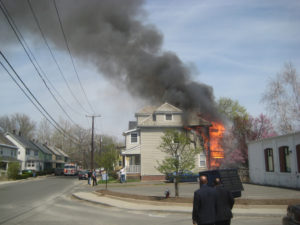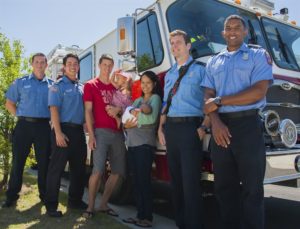What do Fire Departments Do?
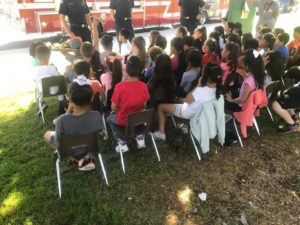 Photo Credit – Brent Faulkner
Photo Credit – Brent Faulkner
The other day, my crew and I were giving a Community Risk Reduction presentation to a few first grade classes for the fire department where I work. This is one of the “bread and butter” Community Risk Reduction services most departments provide. But today, this class would bring even more clarity to my passion for Community Risk Reduction by the answers to the question, “What do fire departments do?”
The question is a standard one at the beginning of these presentations. My firefighter had asked it many times to many groups. For some reason, the way these classes answered the question was different though. In over 20 years, I’ve heard many answers. Answers from, “you wave to me”, “help people”, “get cats out of trees”, etc. My favorite is when we ask them a question and they say, “One time I saw a fire engine.” That is actually the most popular answer to most of the questions we ask 1st graders.
The Answer to the Question?
Like I was saying, these classes said answers I had heard before, but for some reason it resonated with me this time. Their answers were actually the priorities of a Community Risk Reduction Plan. Many departments have spent a lot of time identifying exactly what their priorities are. These 1st graders did it in the matter of 60 seconds. Their answers in order were, “Put out Fires”, “Help People”, and “Make People Safe”.
Is it really that simple? Are these the Community Risk Reduction priorities fire departments should be following? I had heard all three of these responses a million times before and so have you, but is it really so obvious that a group of 1st graders identified it? Lets examine each of these and see.
Priority 1 – “Put out Fires”
photo credit – www.flickr.com/photos/peretzpup/2434257153/in/photostream/
Wait, putting out fires falls under operations, not prevention. By the time we are putting the fire out, the time for prevention has passed. First of all, we are talking about Community Risk Reduction. Lets get one thing clear, fire prevention is part of Community Risk Reduction, its not the same thing.
If we have a well staffed, trained, and equipped fire department, that is a form of Community Risk Reduction. We can keep the fires that aren’t prevented from spreading. We can prevent the loss of life and injury by keeping the fires from spreading, rescuing the public, and keeping our firefighters safe (Yes, keeping firefighters safe is part of Community Risk Reduction too.). See what I mean, fire prevention is part of Community Risk Reduction, not the same thing. Just like fire operations is part of it too. If our operations personnel thought about Community Risk Reduction this way, we may get more support for our programs and processes.
Priority 2 – “Help People”
Photo Credit – http://www.eglin.af.mil/News/Photos/igphoto/2001561750/
When our communities call 911, we respond. That is what we do, and we do it very well I might add. We do this in a variety of ways. The majority of our calls now are medical, but in many communities the number of calls for service are creeping up as well. Calls for homelessness, substance abuse, domestic violence, gang activity, wellbeing of our elderly, at risk youth, etc. The list can go on and on. Some of these correlate over to medical aids, but many do not. If we could do something about them, the need for a medical aid or a call for service may never come.
Let me first say, these are not just issues for the fire service. For some of these issues, we are not the best to handle them. We can team up with other organizations that are though. The obvious one is law enforcement, Red Cross, and other large organizations for some of them, but even they need help from others. There are many other government, private, service, and religious organizations we can turn to. There is no one size fits all organization that can handle everything. Look for opportunities to work with organizations like schools, churches, youth groups, athletic groups, scouting groups, libraries, and clubs.
Community Risk Reduction is not just the job of the fire service. There is a reason the word “Community” comes first. This is everyones job.
Priority 3 – “Make People Safe”
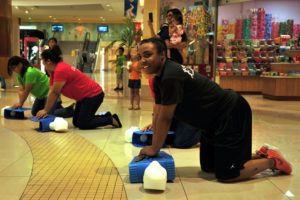 Photo Credits – http://www.andersen.af.mil/News/Photos/igphoto/2000846041/
Photo Credits – http://www.andersen.af.mil/News/Photos/igphoto/2000846041/
The third part of our Community Risk Reduction plan involves making people safe. I am a firm believer that the best way to make people safe is to, “Help them, help themselves.” Safe for what? That is where the saying, “That’s why we get paid the big bucks” comes in. Why are people not safe in our communities? It is different for each of them. Is it because of a natural disaster like an earthquake, wild fire, flooding, tsunami, hurricane, tornado, ice storm, heat wave, etc? Is it socioeconomic like crime, unemployment, hunger, education opportunities, domestic violence, obesity, drugs, at risk youth, or health care issues? It may be many other things as well.
Again, these are not things the fire service can solve on their own. We have a huge stake in many of them. The obvious one is helping our communities prepare for disasters. Not just major disasters, but everyday disasters. Many of the calls I respond to on the fire truck, under different circumstances, would not be necessary if they had some basic information or skills. Here are a few basic examples, but there are many more.
- I just responded to a water leak in a home. They already found the leak and were keeping it from damaging their property when we arrived. They just didn’t know how to shut the water off.
- Many times people call 911 for minor medical issues because, “I want to be seen in the ER faster.”
- “I had no idea an extension cord under my rug could start a fire”
Do we take the opportunity, and make the opportunity, to teach our communities how to take care of themselves? I think we try, but we just don’t have the resources, finances, or personnel to get the word out. We need to continue our efforts in person, but look for opportunities that are virtual. When I say virtual, I mean where one of us doesn’t need to be present.
Virtual Community Risk Reduction
There are many different ways this work can be done virtually. Any material we can give our communities “online” qualifies, as does mailers, PSA’s, videos, articles, and many others. We have many groups like Vision 20/20, NFPA, IAFC, and countless others with reputable, information that we can pass along.
The use of Virtual CRR teaching surveys are perfect to disseminate your safety information. A simple survey you design is sent out to your community. They receive a “report card” regarding their information where they can also find out ways they can improve. That will encourage them to pay more attention to that smoke alarm PSA than if they stumbled upon it on your website. You are also collecting metrics on your community to understand the risks of your community and to see if your CRR efforts are effective. Here is more info on Virtual Community Risk Reduction.
1st Grader Community Risk Reduction
As you can tell, Community Risk Reduction is a passion of mine. The funny thing is, this class of 1st graders taught me how simple and relevant Community Risk Reduction should be. Community Risk Reduction is so much more than fire prevention and it includes the work we do in operations.
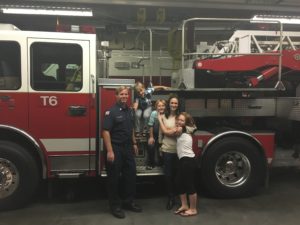 Brent Faulkner is a founding member of MBIntel and now serves as its CEO. He has 20 years of experience in the fire service. During this time, he has responded to numerous emergency situations including structure fires, wildland fires, hazardous materials responses, emergency medical situations, and numerous types of rescues. In addition, he has served on a Type 1 Hazardous Materials Response Team for 14 years.
Brent Faulkner is a founding member of MBIntel and now serves as its CEO. He has 20 years of experience in the fire service. During this time, he has responded to numerous emergency situations including structure fires, wildland fires, hazardous materials responses, emergency medical situations, and numerous types of rescues. In addition, he has served on a Type 1 Hazardous Materials Response Team for 14 years.
Brent had a defining moment in his career which, as a result, lead him to MBIntel. He lead a team in critical infrastructure protection at a recognized Department of Homeland Security (DHS) Terrorism Fusion Center. This team was responsible for increasing the safety of critical infrastructure as it relates to terrorism, general security, and natural disasters. He also specializes in emergency preparedness for homeowners and businesses. He has a master’s degree in management, a bachelor’s degree in occupational studies, an associate’s degree in hazardous materials response, and another in fire science.

